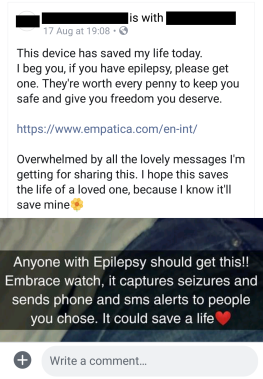What is Embrace?
On a Facebook Group for clinical psychologists a few weeks ago, a member brought to users’ attention the release of Embrace, a “smartbrand for epilepsy management” (official website here). In appearance, Embrace looks very similar to so-called smartwatches (e.g., the Apple Watch, FitBit…).
The website claims that the device can identify the occurrence of convulsive seizures in people with epilepsy via machine learning. The watch collects information such as electrodermal activity (galvanic skin responses), motion detection, and heart rate changes; specific algorithms incorporating this are then, in turn, able to detect in real-time if and when the watch owner is having a tonic clonic seizure.
Embrace is paired to a smartphone app, downloadable by individuals selected by the watch owner’s (e.g., family members). The app alerts them immediately of when their cared one is presenting with a convulsive seizure, either via a text or a phone call. The app also provides them with information regarding the person’s location, so that they know where they can attend to them to provide help.

Picture taken from the official website
The design is smart and modern, and the colours of the wristband and screen can be personalised. Similarly to other smartwatches, Embrace also provides with information regarding sleep, rest, and physical activity. The appealing design and its functionalities, not all relating to epilepsy management and often sought after in more common smartwatches, are likely to make it more appealing and acceptable for users.
Does it work?
In February this year, Embrace obtained approval by the U.S. Food and Drug Administration (FDA) as a medical device. My understanding, having done some brief reading on the subject for the scope of this post, is that there is growing recognition that measurement of changes in electrodermal activities can indeed help to detect seizures (e.g., Poh et al. 2012). The evidence base is still in its early days though, and on their website Embrace acknowledges that their research team is still working on improving and refining their technology and algorithms.
According to their website, Embracing is currently running a clinical trial, comparing biometric data collected from the watch with e-diary seizure report information. This should allow to gather more detailed information regarding pitfalls such as e.g. incorrect seizure dectections or undetected seizures, and therefore gain more data regarding the validity and reliability of the instrument, as well as identifying areas for improvement.
Interestingly, on social medias as well as on Embrace’s blog it is possible to find several success stories and positive reviews of owners of the smartwatch, with some users stating that Embrace even “saved their lives“, allowing them to receive immediate help at the time of severe seizures. Many of the stories are touching, revealing that the watch has indeed the potential to help certain people.
From Facebook:

From Embrace website, one of the “success stories”:

How much does it cost?
At the time I am writing this post, Embrace costs $249 (USD) (approximately £190). An active subscription to the app is also required. The app fee varies depending on functionalities , from $9.90 to $44.90 per month.Embrace can be purchased and shipped to the UK for a delivery cost of $19.90.
Concluding comments
Overall the impression (as a non medically-trained clinician) is that more rigorous research is needed on the effectiveness and limitations of Embrace, which is still in its infancy. However, overall devices such as this do seem to have great potential and to be (generally) well-received by the epilepsy community. It is hoped that if the value of this technology is further proved and recognised, devices such as Embrace will start to become more widely available and accessible to individuals from all backgrounds. It would be interesting to hear more opinions of users or clinicians who have either used it or have indirect experience of the effectiveness of the watch.

1 thought on “Embrace: a smartwatch for epilepsy?”